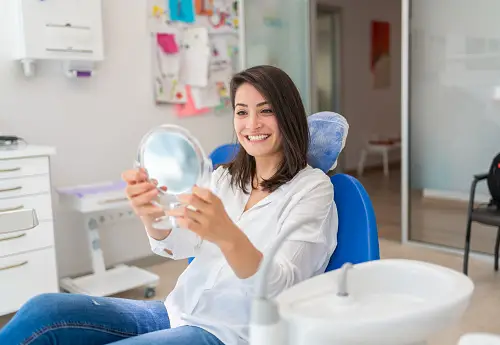
29 Nov Can You Whiten Teeth with Banana Peels? Fact or Fiction?
Bananas and Teeth?
The idea that banana peels can whiten teeth has circulated as a DIY teeth-whitening hack. Proponents of this method claim that the natural compounds found in banana peels, such as potassium, magnesium, and manganese, can contribute to a brighter smile. While there is a modest amount of truth to this claim, it’s essential to understand the limitations and potential risks associated with using banana peels for teeth whitening.
Banana peels do contain some compounds that may have mild teeth-whitening properties. For example, potassium is known to help reduce surface stains on teeth. Additionally, the peels have a slightly abrasive texture, which could assist in mechanically removing plaque and superficial stains.
Here’s a simple guide on how some people use banana peels for teeth whitening:
Select a Ripe Banana
Choose a ripe banana, as it is believed to have a higher concentration of the compounds thought to contribute to teeth whitening.
Peel the Banana
Peel the banana and cut or break it into small sections for easier handling.
Rub the Inside of the Peel on Your Teeth
Gently rub the inside of the banana peel against your teeth for about two minutes. Ensure that the inner part of the peel makes contact with your teeth.
Allow Residue to Sit
Leave the residue on your teeth for a few minutes to allow the compounds to interact with the tooth surface.
Brush Your Teeth
After the specified time, brush your teeth with regular toothpaste to remove any remaining banana residue.
While some individuals claim to have observed slight improvements in tooth whiteness using this method, scientific evidence supporting the efficacy of banana peels for teeth whitening is limited. The mild abrasive action and the presence of potassium may help with superficial stains, but for more noticeable and long-lasting results, professional teeth whitening or dentist-recommended at-home whitening products are generally more effective.
It’s crucial to consider the following points:
Safety Concerns
While banana peels are generally safe to use, there is a risk of damaging your teeth if the peels are too abrasive or if you apply excessive pressure during the rubbing process. Abrasive materials can contribute to enamel wear and tooth sensitivity over time.
Limited Whitening Potential
Banana peels may have a modest impact on surface stains but are unlikely to provide significant whitening for deep-seated or intrinsic discoloration.
Individual Variability
The effectiveness of using banana peels for teeth whitening may vary among individuals. Factors such as the cause of tooth discoloration, oral hygiene habits, and overall dental health can influence the results.
Scientific Support
While anecdotal evidence exists, there is a lack of scientific studies demonstrating banana peels’ consistent and significant teeth-whitening effects.

Myths and Whitening Teeth
Using a banana peel for teeth whitening is a natural and low-cost method that some people find interesting to try. However, it’s essential to approach this method with realistic expectations and understand that the results may be subtle, if noticeable at all
A bright, white smile is often associated with good oral hygiene and is considered an aesthetic asset. As a result, numerous myths about teeth whitening have circulated, leading people to believe in quick fixes or avoid certain practices. Let’s look at some other very popular myths to whiten teeth.
Myth 1: Baking Soda is a Miracle Whitener
One prevailing myth is that brushing your teeth with baking soda will magically whiten them. While baking soda does have mild abrasive properties that can help remove surface stains, it is not a comprehensive solution for teeth whitening. Using baking soda excessively can erode tooth enamel, leading to increased tooth sensitivity and other dental issues. Professional teeth whitening products are formulated with balanced ingredients to ensure effective whitening without causing harm to the enamel.
Myth 2: Activated Charcoal Whitens Teeth Naturally
Activated charcoal has gained popularity as a natural teeth whitener in recent years. However, its effectiveness is often overestimated. While activated charcoal can absorb surface stains and particles, limited evidence supports its long-term teeth-whitening benefits. Moreover, using charcoal products regularly can be abrasive and may contribute to enamel erosion. For safe and effective teeth whitening, it’s best to consult with a dentist and use products specifically designed for that purpose.
Myth 3: Fruit Acids Whiten Teeth Without Consequences
Some people believe that the acids found in fruits, such as lemons and strawberries, can naturally whiten teeth. While these fruits contain natural acids that may help break down surface stains, they also contain sugars that can contribute to tooth decay. Additionally, the acidic nature of these fruits can erode tooth enamel over time. Using them as a teeth whitening method without proper precautions can lead to more harm than good. It’s essential to balance the potential benefits with the risks and consult with a dentist for safer alternatives.
Myth 4: Whitening Toothpaste Can Transform Your Smile Overnight
Many toothpaste brands claim to have miraculous whitening properties, but the reality is more nuanced. Whitening toothpaste typically contains abrasive particles and mild chemical agents that can help remove surface stains. However, these toothpastes may not provide significant whitening results on their own, especially for deep-seated stains. Professional teeth whitening procedures or at-home whitening kits recommended by dentists are more effective options for achieving noticeable and lasting results.
Myth 5: DIY Hydrogen Peroxide Solutions are Safe and Effective
Hydrogen peroxide is a common ingredient in many teeth whitening products, leading some individuals to experiment with DIY solutions. However, it’s crucial to understand that the concentration and application of hydrogen peroxide should be carefully controlled to avoid damage to the teeth and gums. Using homemade mixtures without proper guidance can lead to uneven results, increased tooth sensitivity, and potential damage. Dentists use controlled concentrations of hydrogen peroxide in professional whitening treatments to ensure safety and effectiveness.
Myth 6: Whitening Strips Work Equally for Everyone
Over-the-counter whitening strips have become popular for those seeking at-home teeth whitening solutions. However, it’s a common misconception that these strips work equally well for everyone. The effectiveness of whitening strips can vary based on factors such as the severity of stains, the initial shade of teeth, and individual responses to the whitening agents. Consulting with a dentist before using whitening strips can help determine the most suitable option and avoid potential disappointments.
Myth 7: Teeth Whitening Damages Tooth Enamel
There’s a misconception that teeth whitening procedures, whether done professionally or with over-the-counter products, damage tooth enamel. In reality, reputable teeth whitening methods are designed to minimize any potential harm to enamel. Professional teeth whitening treatments, in particular, are carefully formulated to provide effective results without compromising the integrity of the enamel. It’s crucial to follow instructions and seek professional guidance to ensure the safety of any teeth whitening procedure.
Myth 8: All Teeth Whitening Procedures Are Equally Safe
While professional teeth whitening procedures conducted by trained dental professionals are generally safe, not all teeth whitening methods are created equal. Over-the-counter products and DIY solutions may lack the precision and safety measures incorporated into professional treatments. Choosing reputable products and following instructions carefully to minimize potential risks is essential. Consulting with a dentist before undergoing any teeth whitening procedure ensures a personalized approach that considers individual oral health and potential sensitivities.
Myth 9: Professional Teeth Whitening Is Only for Cosmetic Purposes
While many people seek professional teeth whitening for cosmetic reasons, there are instances where it serves more than just an aesthetic purpose. Some individuals may have intrinsic stains or discoloration due to factors such as medication use or dental trauma. In such cases, professional teeth whitening can be a valuable solution to improve the overall appearance of teeth and boost self-confidence. Consulting with a dentist allows for a thorough assessment and tailored recommendations based on individual dental needs.

In Truth…
Teeth whitening myths can lead to misconceptions about what is safe and effective for achieving a brighter smile. It’s crucial to separate fact from fiction and approach teeth whitening with a well-informed perspective. Consulting with a dentist, following professional recommendations, and maintaining good oral hygiene practices are key to achieving a whiter smile without compromising dental health. By debunking these popular myths, individuals can make informed decisions to safely and effectively enhance their teeth’ appearance.



Sorry, the comment form is closed at this time.